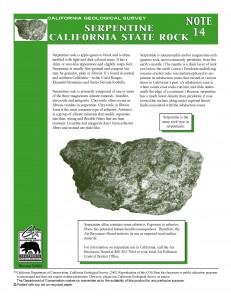
Facts about Serpentine Rock and Soil Containing Asbestos in California. University of California: Division of Agriculture and Natural Resources: http://ucanr.org/freepubs/docs/8399.pdf
World Health Organization International Agency on Cancer Research (asbestos is a known human carcinogen): http://monographs.iarc.fr/ENG/Monographs/suppl7/suppl7.pdf
Chrysotile Asbestos in a California Recreational Area (1979) : http://www.ncbi.nlm.nih.gov/pubmed/493972
Cooper WC, Murchio J, Popendorf W, Wenk HR.
Abstract. Dustfall along roads and trails being used recreationally in the Clear Creek area of San Benito County, California, located in the New Idria serpentinite, was found to be 90 percent or more chrysotile asbestos. Personal samplers worn by
motorcyclists using one of the trails showed concentrations of airborne fibers ranging from 0.3 to 5.3 fibers per milliliter, according to methods prescribed for monitoring occupational exposures. The present workplace standard for brief exposures
to asbestos is 10 fibers per milliliter; 5fibers per milliliter is the proposed standard. The average total dust concentration estimated from personal samplers was approximately 20 milligrams per cubic meter o roughly 90 percent chrysotile. To our knowledge, this is the first demonstration of asbestos exposures of this magnitude, in size ranges known to be pathogenic, resulting from natural deposits not associated with mining, milling, or industrial use.
Environmental Asbestos Pollution Related to Use of Quarried Serpentine Rock (1977): http://www.ncbi.nlm.nih.gov/pubmed/867030
Rohl AN, Langer AM, Selikoff IJ.
Abstract. Crushed serpentinite quarried in Montgomery County, Maryland, has been extensively usedfor paving roads and other surfaces. The mineral assemblage includes antigorite or lizardite as well as chrysotile and tremolite. Air samples taken in
the vicinity ofserpentine-paved roads show that chrysotile concentrations are about 103 times greater than those typicallyfound in urban ambient air in the United States.
Chrysotile Asbestos: Effects of Human Exposure (1977): http://www.sciencemag.org/cgi/content/citation/198/4323/1202
Arthur N. Rohl, Arthur M. Langer And Irving J. Selikoff
Environmental Sciences Laboratory, Mount Sinai School of Medicine of the City University of New York,
New York 10029
ATSDR – Asbestos – Health Effects: http://www.atsdr.cdc.gov/asbestos/asbestos/health_effects/
ATSDR – El Dorado Hills Site – El Dorado County, California: http://www.atsdr.cdc.gov/sites/eldoradohills/index.html
Department of Conservation California Geological Survey Regional Geologic and Hazards Mapping Program: http://www.consrv.ca.gov/cgs/rghm/Pages/index.aspx
Guidelines For Geologic Investigations Of Naturally Occurring Asbestos In California:http://www.conservation.ca.gov/cgs/minerals/hazardous_minerals/asbestos/Documents/Asbestos_Guidelines_SP124.pdf
California Geological Survey – Hazardous Minerals: http://www.conservation.ca.gov/cgs/geologic_hazards/hazardous_minerals/Pages/aviris.aspx
California Geological Survey: Serpentine California State Rock: http://www.conservation.ca.gov/cgs/information/publications/cgs_notes/note_14/Documents/note_14.pdf
Statement from Acting Surgeon General Steven K. Galson about National Asbestos Week: http://www.surgeongeneral.gov/news/pressreleases/pr20090401.html
The Clear Creek Management Area (CCMA) in San Benito and Fresno Counties is located on one of the largest naturally occurring asbestos deposits in the world: http://www.blm.gov/ca/pdfs/hollister_pdfs/Clear_Creek_ROD/ROD-Complete.pdf
Clear Creek Management Area Asbestos Exposure And Human Health Risk Assessment: http://www.epa.gov/Region9/toxic/noa/clearcreek/pdf/CCMARiskDoc24Apr08-withoutAppxG.pdf
EPA Naturally Occurring Asbestos: Approaches for Reducing Exposure: http://www.epa.gov/superfund/health/contaminants/asbestos/noa_factsheet.pdf
EPA Naturally Occurring Asbestos in California: http://www.epa.gov/asbestos/pubs/clean.html
The EPA Region 9 office is working in areas of California to address concerns about potential effects of naturally occurring asbestos: http://www.epa.gov/region9/toxic/noa/
Fact Sheet Naturally Occurring Asbestos (NOA) in El Dorado County: http://www.co.el-dorado.ca.us/emd/apcd/PDF/Fact_Sheet_Naturally_Occurring_Asbestos.pdf
California Department of Health Services Infosheet: Asbestos in the Home and Workplace: http://www.cal-iaq.org/asb00-03.htm
Environmental Health Perspectives: The Case for a Global Ban on Asbestos (National Institute of Environmental Health Science)
http://ehp03.niehs.nih.gov/article/fetchArticle.action?articleURI=info%3Adoi%2F10.1289%2Fehp.1002285
Excerpt:
Background: All forms of asbestos are now banned in 52 countries. Safer products have replaced many materials that once were made with it. Nonetheless, many countries still use, import, and export asbestos and asbestos-containing products, and in those that have banned other forms of asbestos, the so-called “controlled use” of chrysotile asbestos is often exempted from the ban. In fact, chrysotile has accounted for > 95% of all the asbestos used globally.
Objective: We examined and evaluated the literature used to support the exemption of chrysotile asbestos from the ban and how its exemption reflects the political and economic influence of the asbestos mining and manufacturing industry.
Discussion: All forms of asbestos, including chrysotile, are proven human carcinogens. All forms cause malignant mesothelioma and lung and laryngeal cancers, and may cause ovarian, gastrointestinal, and other cancers. No exposure to asbestos is without risk. Illnesses and deaths from asbestos exposure are entirely preventable.
Conclusions: All countries of the world have an obligation to their citizens to join in the international endeavor to ban the mining, manufacture, and use of all forms of asbestos. An international ban is urgently needed. There is no medical or scientific basis to exempt chrysotile from the worldwide ban of asbestos.
Environmental Health Perspectives: A Worn-Out Welcome: Renewed Call for a Global Ban on Asbestos (National Institute of Environmental Health Science
http://ehp03.niehs.nih.gov/article/fetchArticle.action?articleURI=info%3Adoi%2F10.1289%2Fehp.118-a298)
Excerpt:
The asbestos industry argues that chrysotile can be safe with “controlled use,”9 but multiple studies10 have indicated it is unsafe under any circumstances. The International Agency for Research on Cancer,11 U.S. Environmental Protection Agency (EPA),12 and National Toxicology Program13 have declared all forms of asbestos to be known human carcinogens. In 2006, the International Labour Organization and the World Health Organization both called for asbestos use, including all use of chrysotile, to cease worldwide.14,15
California Department of Toxic Substances Control (DTSC) Press release announcing findings regarding serpentine roads
http://www.dtsc.ca.gov/PressRoom/upload/NEWS_2005_T-19-05.pdf
Excerpt: Citing an elevated health risk associated with airborne asbestos from unpaved roads and driveways, the California Department of Toxic Substances Control (DTSC) today released its findings from a scientific study and recommended that roads and driveways covered with serpentine gravel, which may contain naturally occurring asbestos, be resurfaced. The study, conducted in Garden Valley by DTSC with the assistance of the U.S. Department of Transportation, John Volpe National Transportation Systems Center (Volpe Center) and the California Office of Environmental Heath Hazard Assessment (OEHHA), concluded that airborne asbestos generated from vehicle traffic may pose a significant health risk and that resurfacing the roadway substantially reduces the amount of asbestos in the air.
